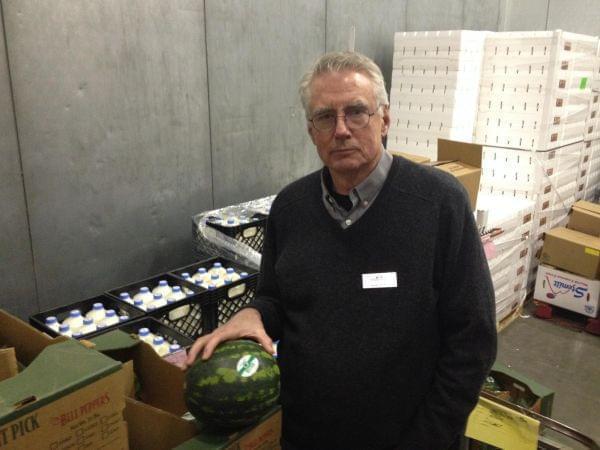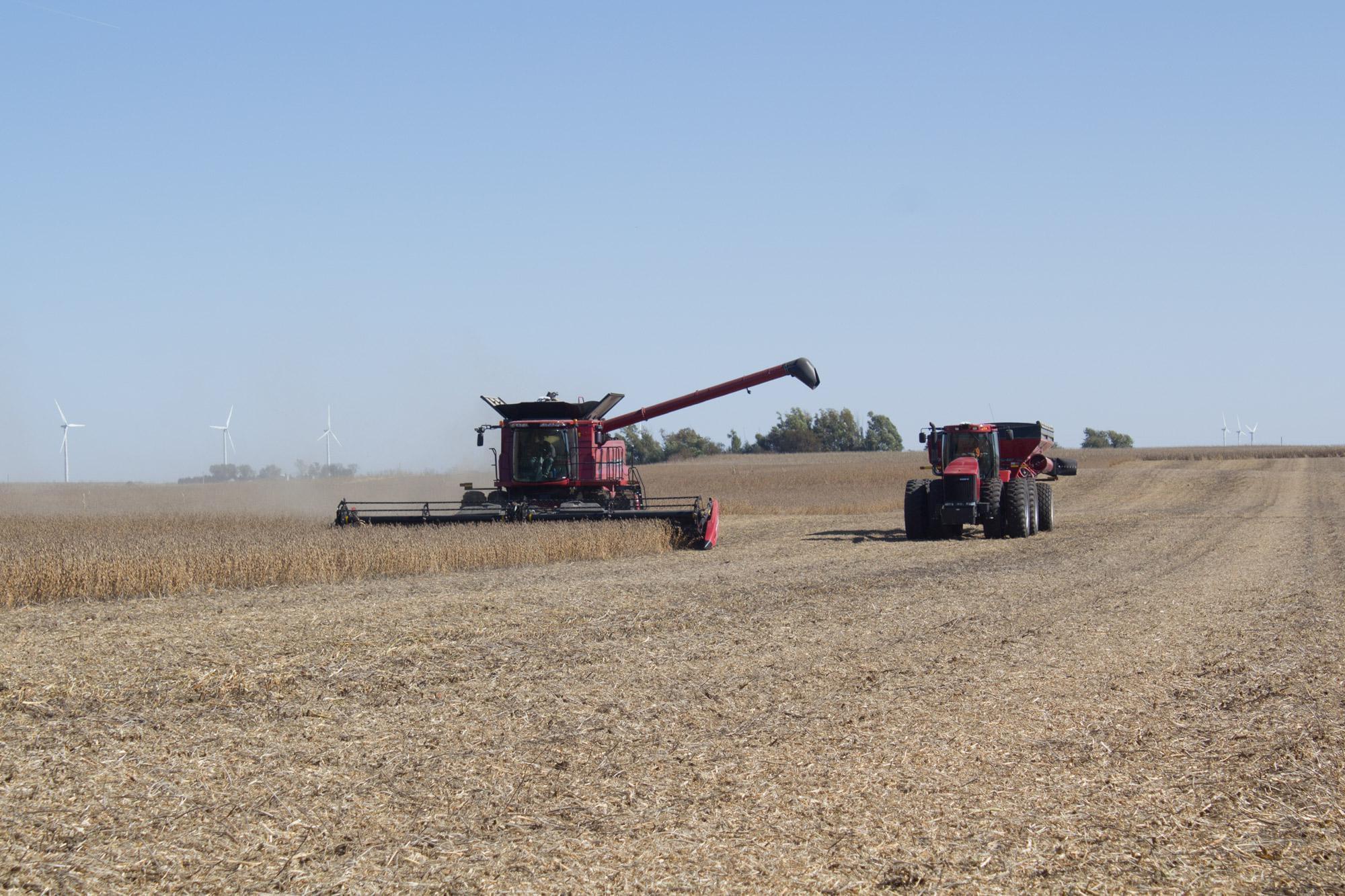What’s Open, What’s On Hold For Food And Ag During The Government Shutdown

Inside the walk-in cooler at the Food Bank of Lincoln, Nebraska, director Scott Young has milk and fresh fruit from the federal government thanks to a trade-mitigation program that delivered the food despite the partial shutdown. Grant Gerlock/Harvest Public Media
The long tentacles of the partial federal government shutdown are reaching especially deep into food and agriculture. Here’s an update on some of the impacts now four weeks into the longest shutdown in history.
On hold
Farm Service Agency offices
U.S. Department of Agriculture Secretary Sonny Perdue announced Wednesday that after being closed for weeks, many Farm Service Agency offices will open for three days to process high-priority needs,like loan checks and tax documents. (Check the list of open offices here.)
Aaron Lehman grows soybeans in central Iowa, and is eligible for a payment the government is offering to offset lost income from the trade war. But he said, FSA office closures have kept him from finishing the application process, and that’s dealt farmers yet another setback during difficult financial times.
“We’re trying to find ways to make ends meet as best we can,” Lehman said, “and having USDA offices shut at this time … the timing is really bad.”
USDA has also said farmers can skip some loan payments until the shutdown ends.
Crop and livestock reports
The National Agricultural Statistics Service produces a wide range of reports, many of them using data culled from surveys of farmers and ranchers. The January cattle report’s surveys went out on time,but there were not enough people left to collate, analyze and publish the data.
“This lack of information adds uncertainty and volatility to the markets,” Iowa State University livestock economist Lee Schulz said. “And so what that means is that while markets react to that information, those reports that came out on a very timely basis, now you're more likely to see markets react to the news of something.”
Announcements of livestock sales or deliveries of crop exports could be helpful in the reports’ absence, but those also might be inaccurate. More significantly, they won’t be simultaneously available to everyone like the USDA reports.

Iowa State University livestock economist Lee Schulz already hasn't been able to put out information he usually provides to farmers because the USDA reports haven't been published on time.
A NASS spokeswoman (who is working part-time and without pay during the shutdown) said when the shutdown is over, the agency intends to publish any reports that were missed. Meanwhile, USDA’s Agricultural Marketing Service, which is responsible for price reports, is continuing to publish daily. Schulz said that’s thanks to a lesson learned during the 2013 government shutdown, which left permanent holes in the price records for commodity sales.
“When you look at that from an analyst standpoint,” he said, “you can really look at it as a statistical catastrophe.”
Farm bill
President Donald Trump signed the massive new farm bill the day before negotiations on funding the government broke down, prompting the shutdown. That means delays in implementing conservation program changes, signing up for crop farming safety nets and launching the new dairy margin coverage program.
“Right before the shutdown, something happened that we were really excited about,” said Alan Bjerga of the National Milk Producers Federation, “and until the shutdown is over, that’s all on hold.”
Bjerga noted that dairy expected to be a big winner in the new farm bill. He’s confident the changes will, eventually, help struggling milk producers.

Soybeans are one of the crops affected by the tariff war. The three-day reopening of some Farm Service Agency offices may allow farmers to complete their applications for money meant to help them recover some of those losses.
Research
Research at USDA labs is largely halted, though university researchers with USDA grants may be able to continue their work if the universities were given the money before the shutdown.
Hiring
The government's E-Verify software, which ensures job applicants are eligible to work in this country is down. That’s not under the USDA’s purview, but it’s essential for farmers hiring seasonal workers.
Not on hold
Food inspections
USDA is responsible for inspecting meatpacking plants, a job that’s gone on uninterrupted. The Food and Drug Administration, which handles most other food inspections, had some hiccups early in the shutdown, but said “high-risk” inspections are back on track as of this week.
SNAP
The Supplemental Nutrition Assistance Program continues, with the government arranging to provide food benefits through February. In many states, people will be getting that month’s benefits early, which is prompting officials to encourage budgeting.
But the USDA has said that it has only about $3 billion in contingency funds, which wouldn’t be enough to cover the $4.8 billion it costs to help feed more than 40 million Americans per month.
Iowa Republican Senator Chuck Grassley said plenty of people are being left vulnerable.
“So we better start thinking about March the 1st,” he said, adding that if people go three days without being able to feed their children, the U.S. “could possibly be only 9 meals away from a revolution.”
In Nebraska, the Food Bank of Lincoln is encouraging SNAP recipients to conserve their benefits to ensure they last as long as possible.
But director Scott Young said they’ve also had an influx of food from a government trade-mitigation program. Crates of half-gallons of milk, packages of grapes, and boxes of watermelons line the large walk-in cooler; there’s even catfish in the freezer.
“This might be the most timely avalanche of commodities ever,” Young said, “as need is liable to spike pretty dramatically here if this thing goes on very much longer.”
Young says his staff has already helped furloughed FBI and other federal workers apply for SNAP benefits as they watched their first checkless payday go by. He has a message for the others: Food is available; come and get some before you reach a crisis point.
Harvest Public Media’s Grant Gerlock and Esther Honig contributed to this report. Follow Amy on Twitter: @AgAmyinAmes
Links
- If Shutdown Drags On, Programs Serving The Hungry In Illinois Could Be At Risk
- State’s Sexual Assault Crisis Centers Struggling During Gov’t Shutdown
- Housing Authority of Champaign Worries Federal Shutdown Could Impact Affordable Housing Programs
- The Longest Government Shutdown In History, No Longer — How 1995 Changed Everything
- Partial Government Shutdown Creates Uncertainty, Inconvenience For Parkland College And U of I
